The recovery of heat from power generation in Scotland: study
This study examines the technical and financial prospects for recovery of heat from four sites used for large scale fossil fuel power generation and then explores policies that could help make the recovery of heat a more practical option.
5 Core Results
This section sets out the core financial and emissions modelling outputs for each of the four power station sites. The core results assume current policy initiatives are in place.
The model results for each power station fit into five different scenarios:
- Scenario 1: An assumed 100% of anchor heat loads are picked up from year 1. In reality this will never be possible, but this result shows the financial returns under the most positive scenario possible, providing a useful yardstick.
- Scenarios 2 to 5: The other results use a 15 year built up of heating load, with heat sales increasing by 7% each year. This reflects the fact that most consumers will not consider connecting until their own boilers fall due for replacement. The timescales for this will depend on each site. In the past the period for heat load to build up has been very long, 20 years or more. With new pressures on customers (high energy costs, CRC etc.) we are assuming a typical build up period of 15 years. Scenarios 2 to 5 progressively test the impact of different levels of connection of heat load falling from 100% to 75% then 50% and finally 25%.
The results for each scenario are coded as P1, L4 etc, i.e. Peterhead scenario 1, Longannet scenario 4 etc. The following table shows the scenario assumptions and codes.
Table 6 Scenario Assumptions
| Scenario Code | Final heat load % of potential | Timescale of heat load build up | |
|---|---|---|---|
| % | years | ||
| Peterhead | P1 | 100% | 1 |
| P2 | 100% | 15 | |
| P3 | 75% | 15 | |
| P4 | 50% | 15 | |
| P5 | 25% | 15 | |
| Hunterston | H1 | 100% | 1 |
| H2 | 100% | 15 | |
| H3 | 75% | 15 | |
| H4 | 50% | 15 | |
| H5 | 25% | 15 | |
| Cockenzie | C1 | 100% | 1 |
| C2 | 100% | 15 | |
| C3 | 75% | 15 | |
| C4 | 50% | 15 | |
| C5 | 25% | 15 | |
| Longannet | L1 | 100% | 1 |
| L2 | 100% | 15 | |
| L3 | 75% | 15 | |
| L4 | 50% | 15 | |
| L5 | 25% | 15 |
5.1 Peterhead
With no additional support the screening process showed that only loads within Peterhead itself would be financially viable to connect to the power station. Around 90%, of the heat load would be non-domestic and it would not be viable to feed most new housing developments. The network would be as follows:
Figure 10 Potential pipe route for Peterhead
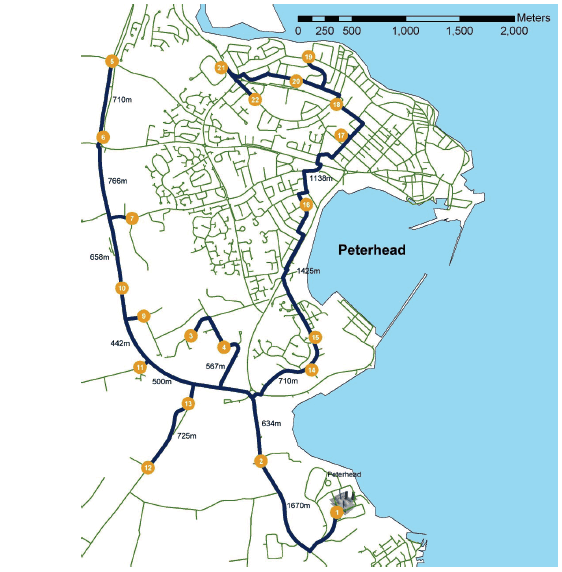
This network has two main legs:
- An eastern leg which runs through Peterhead town supplying existing loads.
- A western leg which largely supplies new development sites.
In practice, it may be desirable to complete the loop between the mixed development (M1) to the northwest and business park 1 to the Northeast. This could provide a level of redundancy in the network for sites to the north of the scheme when maintenance was to be carried out, but this option is not modelled below as it would be less cost effective.
Table 7 Peterhead Heat Sales
| Scenario Code | Final heat load % of potential | Timescale of build up | Final Peak Load | Lifetime Heat Sales |
|---|---|---|---|---|
| % | yrs | MW | MWh | |
| P1 | 100% | 1 | 51.606 | 3,341,323 |
| P2 | 100% | 15 | 51.606 | 2,756,591 |
| P3 | 75% | 15 | 38.704 | 2,067,443 |
| P4 | 50% | 15 | 25.803 | 1,378,296 |
| P5 | 25% | 15 | 12.901 | 689,148 |
Table 8 Peterhead Capital Costs
| Scenario Code | Power Plant Conversion to CHP Capex | DH Capex Incl. distribution, HCUs and heat meters in dwellings less conventional domestic boilers | Total Capex |
|---|---|---|---|
| £ | £ | £ | |
| P1 | £10,788,177 | £10,765,475 | £21,553,652 |
| P2 | £10,788,177 | £10,765,475 | £21,553,652 |
| P3 | £10,788,177 | £9,150,654 | £19,938,831 |
| P4 | £10,788,177 | £6,459,285 | £17,247,462 |
| P5 | £10,788,177 | £3,767,916 | £14,556,094 |
Table 9 Peterhead Scenario Results
| Scenario Code | NPV | IRR | Lifetime Carbon Saving |
|---|---|---|---|
| £ | % | Tonnes CO 2 | |
| P1 | -£2,168,818 | 7.73% | 347,287 |
| P2 | -£11,800,368 | 3.31% | 286,512 |
| P3 | -£12,623,863 | 2.08% | 214,884 |
| P4 | -£12,370,814 | 0.68% | 143,256 |
| P5 | -£12,117,768 | None | 71,628 |
Probably the most likely scenario above is that 75% of identified heat loads would be connected over a 15 year period (P3). Assuming this is the case and the power station also develops the DH scheme then the NPV at DCR of 9% without subsidy is -£12.6M and the IRR to around 2% so a £12.6M net present value subsidy would be required to achieve an IRR of 9%. The capital cost would be around £19.9M (£10.8M to fit heat extraction capability to the power station and £9.1M for the DH network) and the required whole life subsidy as a percentage of capital cost would be around 63%.
Once the network has reached the peak of its development (75% of all identified potential heat load) it would be delivering 63,000 MWh/ Yr of heat to customers and saving 6,500TCO 2/Yr.
The lifetime CO 2 savings would be around 215,000TCO 2 so the lifetime subsidy required to make the scheme cost effective would be around £59/TCO 2.
5.2 Hunterston
Two main pipe routes were initially considered:
- An eastern route, taking in loads in Dalry, Glengarnock and Kilbirnie.
- A southern route, taking in loads in Ardrossan, Saltcoats, Stevenson, Kilwinning, Irvine and the industrial sites south of Irvine.
The eastern route has several long sections without any connected heat loads. The initial logic was driven by the potential industrial anchor heat load in Dalry (Roche). This site already has a CHP system - so there is a high degree of uncertainty over the potential for connecting this load. Without this load the onwards legs to Glengarnock and Kilbirnie would not be financially viable.
As a result the analysis focused on the southern route:
Figure 11 Potential southern pipe route for Hunterston
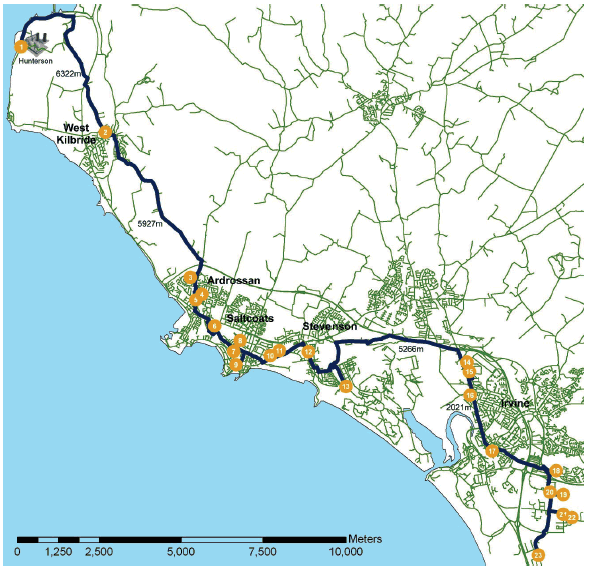
Table 10 Hunterston Heat Sales
| Scenario Code | Final heat load % of potential | Timescale of build up | Final Peak Load | Lifetime Heat Sales |
|---|---|---|---|---|
| % | yrs | MW | MWh | |
| H1 | 100% | 1 | 107.453 | 18,617,060 |
| H2 | 100% | 15 | 107.453 | 15,359,074 |
| H3 | 75% | 15 | 80.590 | 11,519,306 |
| H4 | 50% | 15 | 53.726 | 7,679,537 |
| H5 | 25% | 15 | 26.863 | 3,839,769 |
Table 11 Hunterston Capital Costs
| Scenario Code | Power Plant Conversion to CHP Capex | DH Capex Incl. distribution, HCUs and heat meters in dwellings less conventional domestic boilers | Total Capex |
|---|---|---|---|
| £ | £ | £ | |
| H1 | £27,000,000 | £44,620,175 | £71,620,175 |
| H2 | £27,000,000 | £44,620,175 | £71,620,175 |
| H3 | £27,000,000 | £37,927,149 | £64,927,149 |
| H4 | £27,000,000 | £26,772,105 | £53,772,105 |
| H5 | £27,000,000 | £15,617,061 | £42,617,061 |
Table 12 Hunterston Scenario Results
| Scenario Code | NPV | IRR | Lifetime Carbon Saving |
|---|---|---|---|
| £ | % | Tonnes CO 2 | |
| H1 | £20,249,722 | 12.72% | 1,092,564 |
| H2 | -£27,254,200 | 5.01% | 901,365 |
| H3 | -£31,652,504 | 3.63% | 676,024 |
| H4 | -£31,588,900 | 2.17% | 450,683 |
| H5 | -£31,525,404 | -0.58% | 225,341 |
In scenario H3 assuming this is the case and the power station also develops the DH scheme then the NPV at DCR of 9% without subsidy is -£32M and the IRR to around 3.6% so a £32 M net present value subsidy would be required to achieve an IRR of 9%. The capital cost would be around £65M (£27M to fit heat extraction capability to the power station and £38M for the DH network) and the required whole life subsidy as a percentage of capital cost would be around 49%.
Once the network has reached the peak of its development (75% of all identified potential heat load) it would be delivering around 350,000 MWh/year of heat to customers and saving around 20,500 TCO 2/Yr.
The lifetime CO 2 savings would be around 680,000 TCO 2 so the lifetime subsidy required to make the scheme cost effective would be around £47/ TCO 2.
5.3 Cockenzie
This network is significantly larger than the preceding two examples, with 240 anchor heat loads.
Several main pipe routes were considered as shown below:
Figure 12 Potential pipe route for Cockenzie
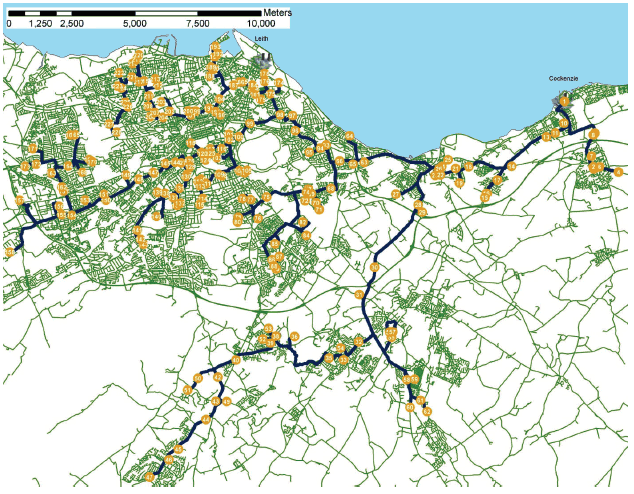
This network is not only larger, but is likely to be more difficult than the others due to:
- The densely packed urban areas served with extensive networks of pipes and cables already in place.
- The potential competition from the proposed biomass plant at Leith.
It should be noted that the south western most leg extending to Penicuik rises a few hundred metres. This will necessitate high static pressures on most of the DH network but will not increase the pumping energy requirement which is purely due to friction as the static head will be recovered in the return leg.
Table 13 Cockenzie Heat Sales
| Scenario Code | Final heat load % of potential | Timescale of build up | Final Peak Load | Lifetime Heat Sales |
|---|---|---|---|---|
| % | yrs | MW | MWh | |
| C1 | 100% | 1 | 222.071 | 24,049,695 |
| C2 | 100% | 15 | 222.071 | 19,840,999 |
| C3 | 75% | 15 | 166.553 | 14,880,749 |
| C4 | 50% | 15 | 111.035 | 9,920,499 |
| C5 | 25% | 15 | 55.518 | 4,960,250 |
Table 14 Cockenzie Capital Costs
| Scenario Code | Power Plant Conversion to CHP Capex | DH Capex Incl distribution, HCUs and heat meters in dwellings less conventional domestic boilers | Total Capex |
|---|---|---|---|
| £ | £ | £ | |
| C1 | £10,788,177 | £158,166,950 | £168,955,127 |
| C2 | £10,788,177 | £158,166,950 | £168,955,127 |
| C3 | £10,788,177 | £134,441,908 | £145,230,085 |
| C4 | £10,788,177 | £94,900,170 | £105,688,347 |
| C5 | £10,788,177 | £55,358,433 | £66,146,610 |
Table 15 Cockenzie Scenario Results
| Scenario Code | NPV | IRR | Lifetime Carbon Saving |
|---|---|---|---|
| £ | % | Tonnes CO 2 | |
| C1 | -£11,505,178 | 8.10% | 2,499,655 |
| C2 | -£92,596,566 | 3.14% | 2,062,216 |
| C3 | -£87,960,720 | 2.31% | 1,546,662 |
| C4 | -£67,508,476 | 1.80% | 1,031,108 |
| C5 | -£47,056,527 | 0.57% | 515,554 |
In scenario C3 assuming this is the case and the power station also develops the DH scheme then the NPV at DCR of 9% without subsidy is -£88 M and the IRR to around 2.3% so a £88M net present value subsidy would be required to achieve an IRR of 9%. The capital cost would be around 145M (£11M to fit heat extraction capability to the power station and £134M for the DH network) and the required whole life subsidy as a percentage of capital cost would be around 61%.
Once the network has reached the peak of its development (75% of all identified potential heat load) it would be delivering around 450,000 MWh/year of heat to customers and saving around 47,000 TCO 2/Yr.
The lifetime CO 2 savings would be around 1,500,000 TCO 2 so the lifetime subsidy required to make the scheme cost effective would be around £57/ TCO 2.
5.4 Longannet
Figure 13 Potential pipe route for Longannet
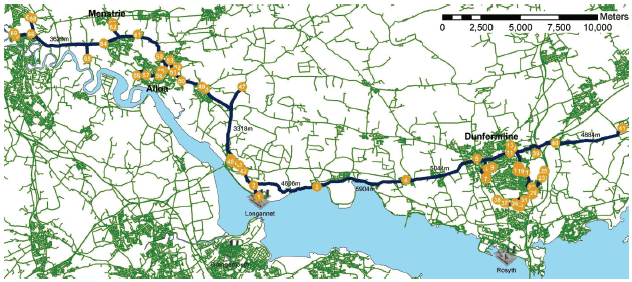
The network extends westward to Stirling and eastward to Dunfermline and beyond to the Exxon Mobile plant at Mossmorran.
The potential to cross the Kincardine Bridge was discounted due to:
- The heat recovery that could be provided from industrial sites in the Grangemouth area - which would not incur the cost of a pipe network to reach, and then cross the Kincardine Bridge and then cross the south bank of the Forth.
- The potential for additional competition from the proposed biomass plant on Grangemouth docks.
Table 16 Longannet Heat Sales
| Scenario Code | Final heat load % of potential | Timescale of build up | Final Peak Load | Lifetime Heat Sales |
|---|---|---|---|---|
| % | yrs | MW | MWh | |
| L1 | 100% | 1 | 162.272 | 21,999,211 |
| L2 | 100% | 15 | 162.272 | 18,149,349 |
| L3 | 75% | 15 | 121.704 | 13,612,012 |
| L4 | 50% | 15 | 81.136 | 9,074,674 |
| L5 | 25% | 15 | 40.568 | 4,537,337 |
Table 17 Longannet Capital Costs
| Scenario Code | Power Plant Conversion to CHP Capex | DH Capex Incl distribution, HCUs and heat meters in dwellings less conventional domestic boilers | Total Capex |
|---|---|---|---|
| £ | £ | £ | |
| L1 | £27,000,000 | £72,948,433 | £99,948,433 |
| L2 | £27,000,000 | £72,948,433 | £99,948,433 |
| L3 | £27,000,000 | £62,006,168 | £89,006,168 |
| L4 | £27,000,000 | £43,769,060 | £70,769,060 |
| L5 | £27,000,000 | £25,531,952 | £52,531,952 |
Table 18 Longannet Scenario Results
| Scenario Code | NPV | IRR | Lifetime Carbon Saving |
|---|---|---|---|
| £ | % | Tonnes CO 2 | |
| L1 | £13,732,958 | 10.85% | 1,117,719 |
| L2 | -£45,414,355 | 4.01% | 922,118 |
| L3 | -£48,104,483 | 2.80% | 691,589 |
| L4 | -£43,502,881 | 1.63% | 461,059 |
| L5 | -£38,898,930 | -0.74% | 230,530 |
In scenario L3 assuming this is the case and the power station also develops the DH scheme then the NPV at DCR of 9% without subsidy is -£48 M and the IRR to around 2.8% so a £48M net present value subsidy would be required to achieve an IRR of 9%. The capital cost would be around 89M (£27M to fit heat extraction capability to the power station and £62M for the DH network) and the required whole life subsidy as a percentage of capital cost would be around 54%.
Once the network has reached the peak of its development (75% of all identified potential heat load) it would be delivering around 410,000 MWh/Yr of heat to customers and saving around 21,000 TCO2/Yr.
The lifetime CO 2 savings would be around 690,000 TCO 2 so the lifetime subsidy required to make the scheme cost effective would be around £70/ TCO 2.
5.5 Comparison of the Core Results for Each Station
The following table shows the key results for all four power station sites, showing the IRR under each of the five scenarios:
Table 19 Key Results
| Scenario Code | Final heat load % of potential | Timescale of build up | IRR | |
|---|---|---|---|---|
| % | years | % | ||
| Peterhead | P1 | 100% | 1 | 7.73% |
| P2 | 100% | 15 | 3.31% | |
| P3 | 75% | 15 | 2.08% | |
| P4 | 50% | 15 | 0.68% | |
| P5 | 25% | 15 | None | |
| Hunterston | H1 | 100% | 1 | 12.72% |
| H2 | 100% | 15 | 5.01% | |
| H3 | 75% | 15 | 3.63% | |
| H4 | 50% | 15 | 2.17% | |
| H5 | 25% | 15 | -0.58% | |
| Cockenzie | C1 | 100% | 1 | 8.10% |
| C2 | 100% | 15 | 3.14% | |
| C3 | 75% | 15 | 2.31% | |
| C4 | 50% | 15 | 1.80% | |
| C5 | 25% | 15 | 0.57% | |
| Longannet | L1 | 100% | 1 | 10.85% |
| L2 | 100% | 15 | 4.01% | |
| L3 | 75% | 15 | 2.80% | |
| L4 | 50% | 15 | 1.63% | |
| L5 | 25% | 15 | -0.74% |
The key points from this are:
- Only two systems make a commercial rate of return of 9% or more are H1 and L1 - both are under the ideal circumstances of 100% load connected in year 1.
- The best rate of return for scenario 2 is for H2 at 5% - however this is far from financially viability.
- The best rate of return for scenario 3 is for H3 at 3.6% - however this is also far from financially viability.
Hence under current policy conditions none of the more realistic options is close to commercially viable. As there are no schemes of this scale of heat demand connected to any UK power station, this is not an unexpected result. However the model allows a range of policy options to be modelled and the core results give an indication of the key issues.
High capital cost is a well-recognised key issue for district heating. The following table shows the funding required enabling each scenario to reach a 9% IRR.
Table 20 Funding requirement levels
| Scenario Code | Final heat load % of potential | Timescale of build up | Funding required to Reach 9% IRR | |
|---|---|---|---|---|
| % | years | £ million | ||
| Peterhead | P1 | 100% | 1 | 2.17 |
| P2 | 100% | 15 | 11.80 | |
| P3 | 75% | 15 | 12.62 | |
| P4 | 50% | 15 | 12.37 | |
| P5 | 25% | 15 | 12.12 | |
| Hunterston | H1 | 100% | 1 | none |
| H2 | 100% | 15 | 27.25 | |
| H3 | 75% | 15 | 31.65 | |
| H4 | 50% | 15 | 31.59 | |
| H5 | 25% | 15 | 31.53 | |
| Cockenzie | C1 | 100% | 1 | 11.51 |
| C2 | 100% | 15 | 92.60 | |
| C3 | 75% | 15 | 87.96 | |
| C4 | 50% | 15 | 67.51 | |
| C5 | 25% | 15 | 47.06 | |
| Longannet | L1 | 100% | 1 | none |
| L2 | 100% | 15 | 45.41 | |
| L3 | 75% | 15 | 48.10 | |
| L4 | 50% | 15 | 43.50 | |
| L5 | 25% | 15 | 38.90 |
This shows that even with 100% load connected (scenario 2); the funding requirements are significant, ranging from £12 million to £92 million.
These are very large sums; however the amount of carbon saved is also significant. Hence the cost effectiveness of the potential funding is key.
The carbon savings are assessed over the 40 year lifetime of each scheme. As heat load builds up over 20 years the carbon savings in year 1 will be small, growing by 5% pa. Because the carbon savings are different in each year it is not possible to give a single figure for annual carbon savings, hence the table below shows the lifetime carbon saving and the funding needed per tonne of lifetime carbon savings.
Table 21 Capital Grant Cost Effectiveness
| Scenario Code | Lifetime Carbon Saved | Funding requirement to Reach 9% IRR | Funding per tonne CO 2 | |
|---|---|---|---|---|
| ktonnes CO 2 | £ million | £/tonne CO 2 | ||
| Peterhead | P1 | 347 | 2.17 | 6.25 |
| P2 | 286 | 11.80 | 41.19 | |
| P3 | 214 | 12.62 | 58.75 | |
| P4 | 143 | 12.37 | 86.35 | |
| P5 | 71 | 12.12 | 169.18 | |
| Hunterston | H1 | 1 | 0.00 | 0.00 |
| H2 | 901 | 27.25 | 30.24 | |
| H3 | 676 | 31.65 | 46.82 | |
| H4 | 450 | 31.59 | 70.09 | |
| H5 | 225 | 31.53 | 139.90 | |
| Cockenzie | C1 | 2 | 11.51 | 4.60 |
| C2 | 2 | 92.60 | 44.90 | |
| C3 | 1 | 87.96 | 56.87 | |
| C4 | 1 | 67.51 | 65.47 | |
| C5 | 515 | 47.06 | 91.27 | |
| Longannet | L1 | 1 | 0.00 | 0.00 |
| L2 | 922 | 45.41 | 49.25 | |
| L3 | 691 | 48.10 | 69.56 | |
| L4 | 461 | 43.50 | 94.35 | |
| L5 | 230 | 38.90 | 168.74 |
This shows a range of cost effectiveness for the more realistic scenarios 2 to 5. This ranges from £30/tonne CO 2 to £168/tonne CO 2. Generally the higher the connection level the better the cost effectiveness.
This has an important lesson for the policy ideas, as policies that can increase connection rates will reduce the gap in capital funding needed and offer better cost effectiveness.
5.5.1 Comparison of Heat Loads
5.5.2 Breakdown between existing and proposed heat customers
The Peterhead network is dominated by proposed loads, hence this network is the most speculative, as there is significant risk that these heat uses are not developed. The Longannet network is dominated by existing users and as such this network is the least speculative.
Figure 14 the breakdown between existing and proposed heat customers for the four sites
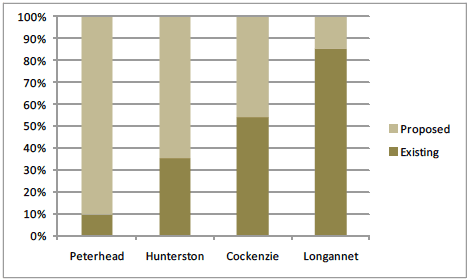
5.5.3 Breakdown between the sectors served
There sectors served by the four stations may be categorised as domestic, public and business. Cockenzie is the closest of the four sites to a large conurbation; hence this has significant heat supply to all three sectors. Hunterston is dominated by heat supply to the business sites around Irvine.
Figure 15 The breakdown between the sectors served for each of the four sites:
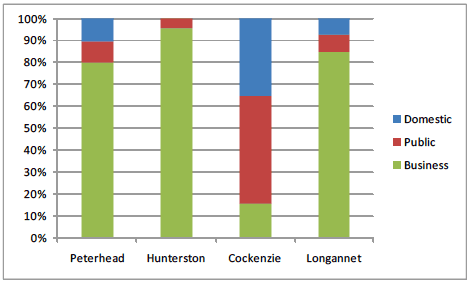
5.6 Sensitivity Analysis
This section tests out how sensitive the core results are to changes in key variables and includes some basic assessment of how capital and revenue support might change investment returns.
Where the sensitivity test takes the IRR above 9%, the target rate, the result is in bold.
5.6.1 Sensitivity to Build out Rate
Tests have been run to show the impact of a more accelerated growth of the heat load.
With a large capital expenditure, increasing the revenue from heat sales at an earlier period has a potentially important impact. We have modelled three scenarios:
- Accelerated heat load build-up of 10 years.
- Accelerated heat load build-up of 5 years.
Table 22 IRR for the 2 sensitivity tests
| 10 Years | 5 Years | |
|---|---|---|
| P2 | 4.56% | 6.13% |
| P3 | 2.61% | 3.74% |
| P4 | 0.23% | 0.94% |
| P5 | None | None |
| H2 | 6.93% | 9.56% |
| H3 | 4.46% | 6.40% |
| H4 | 1.47% | 2.72% |
| H5 | None | None |
| C2 | 4.45% | 6.19% |
| C3 | 2.45% | 3.70% |
| C4 | 0.02% | 0.80% |
| C5 | None | None |
| L2 | 5.78% | 8.14% |
| L3 | 3.42% | 5.16% |
| L4 | 0.53% | 1.66% |
| L5 | None | None |
In no cases does a 10 year build out reach the 9% target IRR. In only one case, H2, does a 5 year build out reach the 9% IRR, however L2 is close to this rate.
As would be expected the test has the greatest impact on Scenario 2 as this has the highest heat loads and hence the highest revenue from heat sales.
In line with the IRR results the funding gap falls very significantly for the Scenario 2 cases.
Table 23 The funding gap for the 2 sensitivity tests:
| Funding gap | 10 Years | 5 Years |
|---|---|---|
| P2 | 9.01 | 5.46 |
| P3 | 12.14 | 9.48 |
| P4 | 15.28 | 13.51 |
| P5 | 18.42 | 17.53 |
| H2 | 13.92 | 0.00 |
| H3 | 28.34 | 15.26 |
| H4 | 42.77 | 34.05 |
| H5 | 57.19 | 52.83 |
| C2 | 70.10 | 40.37 |
| C3 | 94.81 | 72.51 |
| C4 | 119.53 | 104.66 |
| C5 | 144.24 | 136.81 |
| L2 | 28.89 | 7.20 |
| L3 | 46.65 | 30.39 |
| L4 | 64.41 | 53.55 |
| L5 | 82.18 | 76.75 |
5.6.2 Sensitivity to Capital and Revenue Support
The core results emphasis two key financial challenges for district heating:
- The large impact of the high upfront capital costs needed for the heat network. The impact is high as the sums of investment are large and they all occur in year one of the project's financial life.
- The modest impact of the income from heat sales. The impact is modest as the initial heat sales are low and the discounting process reduces the impact of the increasing heat sales in later years.
There are two obvious routes to change the status quo:
- Offer substantial capital funding support
- Offer revenue support on heat sales - a District Heating Incentive
Both of these routes would involve substantial sums of state aid. There are state aid guidelines for environmental support measures - however they tend to focus on renewable energy. The heat from these 4 power stations is predominantly derived from fossil fuel. Hence there will be a significant challenge to gain approval for significant aid. In addition the sums involved are likely to be substantial - raising value for money questions. For the District Heating Incentive this is the type of measure that would probably require UK level primary legislation.
The large scale financial support measures are unlikely to be practical or affordable policy ideas hence they have not been selected for the policy analysis stage of this report. To illustrate the scale of these funding routes and their impact this section provides a sensitivity analysis testing out these ideas.
Capital Funding
The capital costs vary from station to station, depending on the size of the heat network - which depends on the assumption on the level of connections. The following table shows the capital costs under the most extreme scenarios.
Table 24 Summary of Capital Costs
| Power Station Site | Capital for Scenario 1 (100% heat load) | Capital for Scenario 5 (25% heat load) |
|---|---|---|
| Peterhead | £21,553,652 | £14,556,094 |
| Hunterston | £71,620,175 | £42,617,061 |
| Cockenzie | £168,955,127 | £66,146,610 |
| Longannet | £99,948,433 | £52,531,952 |
| Total | £362,077,387 | £175,851,717 |
Hence 10% capital funding would be between £17 and £36 million for all four sites.
For this idea we propose testing the impact of 20% and 40% capital funding on Scenario 3 - 75% heat load within 15 years.
District Heating Incentive
District heating is a major capital investment. The financial returns are dominated by the value of heat sales vs. the high initial capital costs. In general fiscal support for low carbon technologies are moving towards revenue incentives, e.g. ROCs, FIT and the RHI.
This idea tests the impact of a District Heating Incentive - paid on the sales of heat. This would be similar in concept to the RHI. The proposals for the RHI included a possible uplift for renewable heat supplied via district heating. As currently implemented the RHI does not have this uplift.
This tests the impact of rewarding heat from district heating with the RHI level for biomass boilers over 1 MW, i.e. 2.6 p/ kWh and at half this level 1.3 p/ kWh.
Capital and Revenue Support Results
The table below shows that with high levels of capital or revenue support that in two cases Scenario 3 can improve from a low IRR of 2.08% to3 3.36% to levels above the 9% threshold.
Table 25 Results of Capital and Revenue Support Ideas
| Longannet | Hunterston | Cockenzie | Peterhead | |||||
|---|---|---|---|---|---|---|---|---|
| Policy | NPV | IRR | NPV | IRR | NPV | IRR | NPV | IRR |
| No Support | -£48,104,483 | 2.80% | -£31,652,504 | 3.63% | -£87,960,720 | 2.31% | -£12,623,863 | 2.08% |
| Heat Incentive equivalent to RHI | £17,900,253 | 10.48% | £24,204,688 | 11.61% | -£15,803,867 | 8.14% | -£2,598,817 | 7.98% |
| Heat Incentive equivalent to RHI/2 | -£15,102,115 | 7.55% | -£3,723,908 | 8.53% | -£51,882,293 | 5.79% | -£7,611,340 | 5.60% |
| 40% Capital Grant | -£12,502,016 | 6.65% | -£5,681,644 | 7.60% | -£29,868,686 | 5.65% | -£4,648,331 | 5.26% |
| 20% Capital Grant | -£30,303,250 | 4.39% | -£18,667,074 | 5.26% | -£58,914,703 | 3.68% | -£8,636,097 | 3.40% |
The table below shows the financial cost of each of these ideas. In the case of capital support this is simply the value of the capital grant. In the case of the District Heating Incentive it is the NPV of the annual support.
The following charts show the impact of these ideas.
Figure 16 Sensitivity Results for Longannet
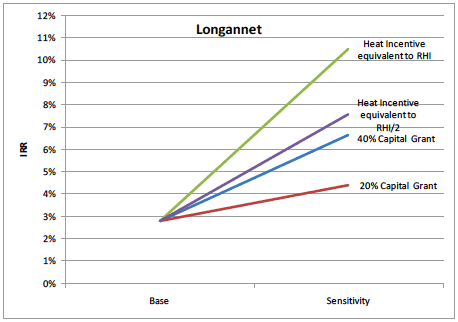
Figure 17 Sensitivity Results for Hunterston
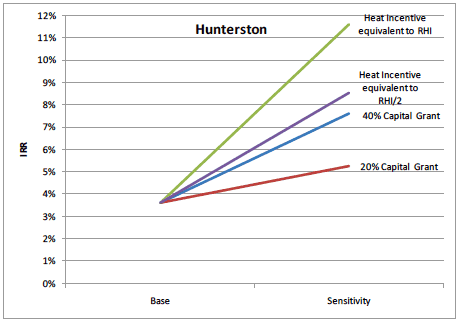
Figure 18 Sensitivity Results for Cockenzie
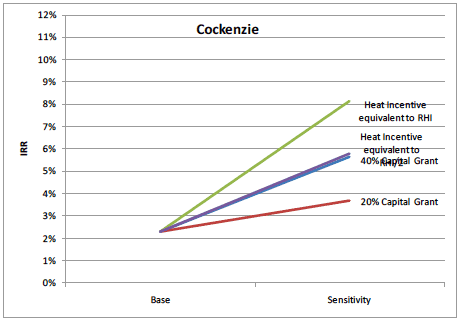
Figure 19 Sensitivity Results for Peterhead
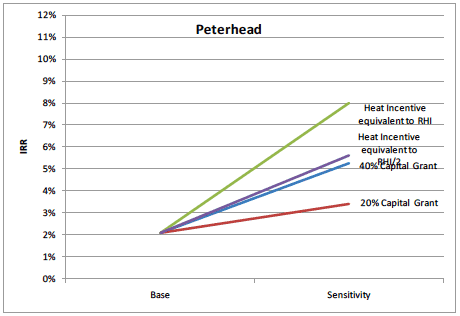
The following table shows the costs of these sensitivity tests.
Table 26 Cost of Capital and Revenue Sensitivity Tests
| Longannet | Hunterston | Cockenzie | Peterhead | |
|---|---|---|---|---|
| Policy Cost WLC | Policy Cost WLC | Policy Cost WLC | Policy Cost WLC | |
| Heat Incentive equivalent to RHI | £66,004,737 | £55,857,192 | £72,156,853 | £10,025,047 |
| Heat Incentive equivalent to RHI/2 | £33,002,368 | £27,928,596 | £36,078,427 | £5,012,523 |
| 40% Capital Grant | £35,602,467 | £25,970,860 | £58,092,034 | £7,975,532 |
| 20% Capital Grant | £17,801,234 | £12,985,430 | £29,046,017 | £3,987,766 |
5.6.3 Conclusions on Sensitivity Tests
A small number of the sensitivity tests show that the target rate of a 9% IRR can be met. These are:
- Accelerating the build-up of the heat load from 15 years to 5 years.
- A high level of revenue support, similar in level to the Renewable Heat Incentive.
Of these two the revenue support is not a practical option. The NPV of the revenue support is higher than the funding gap. For Longannet the NPV of the revenue support is £66 million, whereas the funding gap is £45 million. In addition it would be difficult to present a State Aids cased to support heat from a fossil fuel source at the same support level as heat from renewable sources.
This suggests that:
- Policy measures to bring forward heat sales are a more affordable and practical option than revenue incentives.
- Policy measures that can reduce the costs of the heat network, e.g. by co-locating heat demand and heat supply, could play an important role.
Hence planning policy has an important role to play.
There is a problem
Thanks for your feedback